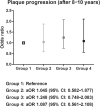Differences in complication patterns in subgroups of type 2 diabetes according to insulin resistance and beta-cell function
- PMID: 35672344
- PMCID: PMC9174240
- DOI: 10.1038/s41598-022-13084-6
Differences in complication patterns in subgroups of type 2 diabetes according to insulin resistance and beta-cell function
Abstract
This study aimed to determine whether the patterns of diabetic complications differed when patients with type 2 diabetes mellitus (T2DM) were simply classified according to insulin sensitivity and beta-cell function. This observational study included 8861 patients with T2DM who underwent concurrent testing for fasting glucose, fasting insulin, and one or more diabetic complications. We categorized the patients into four groups according to insulin sensitivity and beta-cell function. Compared with the reference group (mild insulin resistance and beta-cell dysfunction), the "severe beta-cell dysfunction" group had lower odds of chronic kidney disease [adjusted odds ratios (aOR) 0.611]. The "severe insulin resistance" group had higher odds of carotid artery plaque presence (aOR 1.238). The "severe insulin resistance and beta-cell dysfunction" group had significantly higher odds of large fiber neuropathy (aOR 1.397, all p < 0.05). After a median of five years of follow-up, this group distinction did not lead to a difference in risk of new diabetic retinopathy or chronic kidney disease. In addition, there was no significant difference among the groups in plaque progression risk over 8-10 years in the longitudinal follow-up analysis. The patterns of complications differ when patients with T2DM are classified according to insulin resistance and beta-cell dysfunction. However, there were no differences in the risk of developing new complications.
© 2022. The Author(s).
Conflict of interest statement
The authors declare no competing interests.
Figures




Similar articles
-
The relationship between chronic kidney function and homeostasis model assessment of insulin resistance and beta cell function in Korean adults with or without type 2 diabetes mellitus.Endocr J. 2017 Dec 28;64(12):1181-1190. doi: 10.1507/endocrj.EJ17-0274. Epub 2017 Sep 9. Endocr J. 2017. PMID: 28890482
-
[Role of insulin resistance and β cell function in the development of newly diagnosed type 2 diabetes].Wei Sheng Yan Jiu. 2015 Nov;44(6):881-6. Wei Sheng Yan Jiu. 2015. PMID: 26738376 Chinese.
-
Diabetic Retinopathy in Newly Diagnosed Subjects With Type 2 Diabetes Mellitus: Contribution of β-Cell Function.J Clin Endocrinol Metab. 2016 Feb;101(2):572-80. doi: 10.1210/jc.2015-2203. Epub 2015 Dec 11. J Clin Endocrinol Metab. 2016. PMID: 26652932
-
Type 2 diabetes mellitus.Nat Rev Dis Primers. 2015 Jul 23;1:15019. doi: 10.1038/nrdp.2015.19. Nat Rev Dis Primers. 2015. PMID: 27189025 Review.
-
Changing the Concept of Type 2 Diabetes: Beta Cell Workload Hypothesis Revisited.Endocr Metab Immune Disord Drug Targets. 2019;19(2):121-127. doi: 10.2174/1871530318666180821161825. Endocr Metab Immune Disord Drug Targets. 2019. PMID: 30173655 Free PMC article. Review.
Cited by
-
Effects of insulin resistance and β-cell function on diabetic complications in Korean diabetic patients.PLoS One. 2024 Oct 22;19(10):e0312439. doi: 10.1371/journal.pone.0312439. eCollection 2024. PLoS One. 2024. PMID: 39436903 Free PMC article.
-
Association between age at diagnosis of diabetes and ocular disease: Insights from a recent article.World J Diabetes. 2025 Jan 15;16(1):94846. doi: 10.4239/wjd.v16.i1.94846. World J Diabetes. 2025. PMID: 39817215 Free PMC article.
References
-
- Li L, et al. Identification of type 2 diabetes subgroups through topological analysis of patient similarity. Sci. Transl. Med. 2015;7:311174.
-
- Tanabe H, et al. Factors associated with risk of diabetic complications in novel cluster-based diabetes subgroups: A Japanese retrospective cohort study. J. Clin. Med. 2020;9:2083. doi: 10.3390/jcm9072083. - DOI
Publication types
MeSH terms
Substances
LinkOut - more resources
Full Text Sources
Medical

